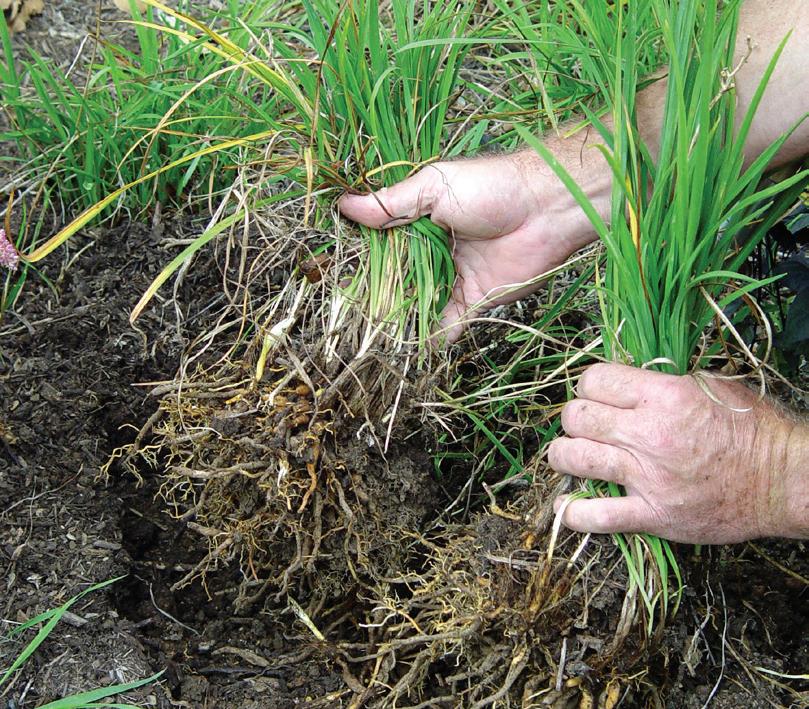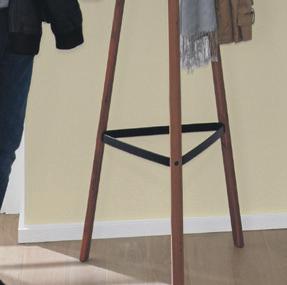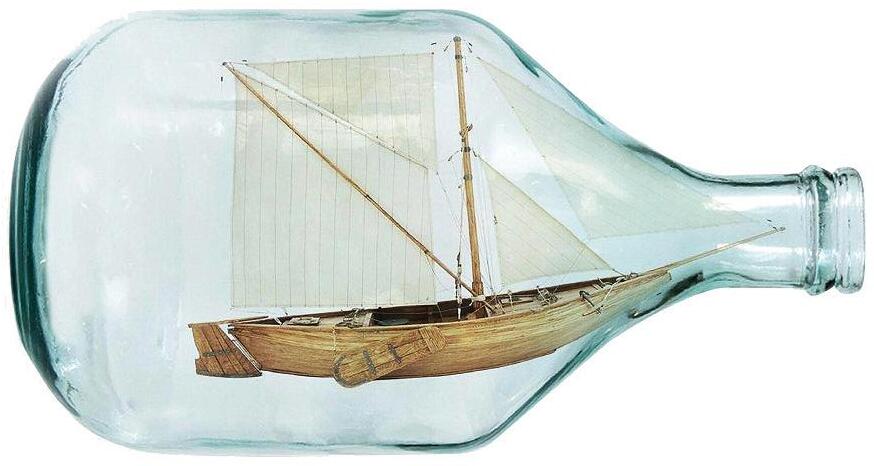




Page 4






From the French Quarter to the hometown of Mark Twain, experience the best of this legendary river. On an 8 to 23-day journey, explore Civil War history and travel to the epicenter of American music as you cruise in perfect comfort aboard our brand new American Riverboat™.























March 2024 • Volume 72, No. 3
CEO Michael Shepard
SENIOR VP OF CONTENT Leon Espinoza
EDITORIAL DIRECTOR Mike Teegarden, CCC
DEPUTY EDITORIAL DIRECTOR
Noble Sprayberry
SENIOR EDITOR Jennifer Paton, CCC
ASSISTANT EDITORS Chasity Anderson, CCC; Victoria Hampton, CCC, David Herder CCC
ASSOCIATE EDITORS
Valeri Pearon, Nina Todea
PUBLICATIONS PRODUCTION SR. MANAGER
Elizabeth Beatty
PUBLICATIONS COORDINATOR
Alyssa McDougle
Ruralite (USPS 397-460) is published monthly for members for $4.83 per year, plus postage, by Pioneer Utility Resources Inc., 5625 NE Elam Young Pkwy. Ste. 100, Hillsboro, OR 97124—a not-for-profit Oregon cooperative corporation—to serve the communication needs of 47 consumer-owned electric utilities in Oregon, Washington, Alaska, Idaho, Nevada and California. Preferred periodical postage paid at Hillsboro, Oregon, 97123 and additional mailing offices. © 2024 Pioneer Utility Resources. All rights reserved. Reproduction in whole or in part without written permission is prohibited.
Postmaster: Send address changes to Ruralite, 5625 NE Elam Young Pkwy. Ste. 100, Hillsboro, OR 97124-6454
HOW TO CONTACT RURALITE
Subscription services:
Nonmember subscriptions $15 (U.S.) per year; $25 per year (foreign). Prepayment required. Allow 4-8 weeks for first issue. Be sure to identify which local edition you want to receive.
Address Changes:
Utility members, contact your local utility. Subscribers, call us at 503-357-2105 option 3 or email mailingdept@pioneer.coop.
Back issues:
Back issues and extra copies $3. Prepayment required. Supply is limited. Be sure to identify edition, month and year. Call first if ordering back issues to check availability.
To contact Ruralite: Ruralite magazine is published by Pioneer Utility Resources.
P.O. Box 1306, North Plains, OR 97133-1306; 503-357-2105; email: info@pioneer.coop. For more information, visit www.pioneer.coop.
DISPLAY ADVERTISING INQUIRIES
American MainStreet Publications
611 S. Congress Ave., Ste. 504 Austin, TX 78704
800-626-1181 or 512-441-5200

For supplemental and interactive content, search @Ruralite on your favorite social media sites.
I don’t know about you, but I am itching to get outside and get my hands dirty. As soon as the soil in my flower beds stops feeling like overly thickened pudding, I’m ready to purge the winter blahs—and the weeds that have sprouted.
I have a few new flower beds that will get my attention first. One area is a clean slate just waiting for inspiration and the right plants to transform it.

I’m a lazy gardener, favoring native perennials that require little care while providing vibrant color year after year. Over time, I want to fill in the open spaces with low-creeping plants that reduce the need for weeding. I’m not there yet, but this month’s gardening story gave me great ideas on ways to reach my goals while saving money. I haven’t grown plants indoors from seeds since my days in elementary school, but I’m excited to give it a try again.

When the weather is too cold to work my flower beds, my family loves to play board games. We have an overflowing game closet. I was pretty excited when I ran across a company in Pahrump, Nevada, which helps game developers take their ideas to the finish line. You can read about it on Page 10. Maybe one of you will design the next must-have board game.
As we continue celebrating Ruralite’s 70th year, please look at the Before You Go story on Page 30. From time to time this year, we will share nuggets from some of the first issues of Ruralite magazine. This month, we feature new product descriptions and household tips that ran in December 1954.
Sincerely,
Mike Teegarden Editorial Director
Innovator leads the way to a successful board game design business Up Close, Page 10

Story and photos by Craig Reed
For several years, Scott and Kelly Barrows talked about their goal of growing as much of their food as possible.
In March 2021, the couple decided not only to grow their own food full time, but also open a business, Little Fall Creek Farm, sharing their homemade and pasture-raised products with the public.
“We wanted to grow our food here, we wanted to grow our family here,” says Kelly of the couple’s property alongside Little Fall Creek 17 miles southeast of Springfield.
The Barrows sell poultry, milk, eggs, artisan sourdough bread, cookies and other baked items. They open their farm Sundays from 10 a.m. to 4 p.m. year-round and sell all their products from there.
A statement on the farm’s website explains the beginning of the business.
“Our long-shared interest in gardening and raising livestock began to come to fruition a decade ago when we lived on a neglected family plot that was once a thriving farm. Since then, we’ve been raising rabbits, various poultry, sheep and goats, pigs and bees.”
Nick Leidig has been a regular Sunday visitor and customer to Little Fall Creek Farm.
“The farm has become a magnet for the community who gather to stock up on weekly supplies of meat, milk, eggs and delightful baked goods,” Nick says. “Scott and Kelly try to have all your favorites available, yet are always dreaming up innovative new offerings to entice you out of your rut to try some new treat.”
JJ Boggs is another customer of the farm since its first Sunday of business.
“Scott and Kelly put so much love and care into their products, from the ingredients they choose to the flavor combinations and the way they raise their animals,” she says. “Guaranteed if you stop by once, you’ll soon be dreaming about your next visit and that delicious loaf of bread, new doughnut glaze or chicken dinner.
“They have been such a great fit to the Fall Creek community,” she adds. “Their farm offers such a peacefulness that you can experience with their family, animals and the environment they’ve created. It’s worth the drive to their farm.”
Scott and Kelly were apartment dwellers when they were college students—Kelly at the University of Oregon and Scott at Lane Community College. They met at the coffee shop where Scott was working. They married 13 years ago.
After moving to their farm 10 years ago, Scott worked off the farm for seven years and then spent his free time working with Kelly on developing their property. They now have 5 acres in food production.
“We didn’t have a concrete plan or idea for what we wanted to grow into, but we knew we wanted to get started,” Kelly says. “We put a lot of attention into being flexible for what works for the business and for our family.”
Scott, 39, and Kelly, 37, have five children—Suzanna, 10, Harrison, 7, Malcolm, 5, Otis, 3, and 3-month-old Luella—who help with small jobs on the farm and are the greeters and errand runners during Sunday’s business hours. Suzanna is in training to help with milking the goats.
“We’re exceptionally grateful for where we’re at with the farm,” Scott says. “The goal was to provide for our family, producing the best food we could, and now we’re sharing what we feed our family with visitors to the farm. The local support has been the best part. I can’t believe how much support we’ve received.”
The Barrows mill their own flour from whole organic grains. They use eggs, milk and honey from the farm in their baking of sourdough breads, sourdough doughnuts and sourdough sweet potato cinnamon rolls, cookies, pies, biscuits, coffee cakes and pastries.
“Kelly makes the most amazing bread,” Scott says.
Pasture-raised chicken, turkey and duck, and eggs from those birds are also available. The poultry are moved daily or every other day to fresh grass on a rotational grazing schedule.
“We’re both hard workers,” Scott says. “I love the work, I love the diversity of it.”
Kelly admits they started out with “scattershot projects to see what would stick.” They’ve discovered what is popular with the public and are now looking to expand their goat milk production, plant and grow berry bushes and grow vegetables in high-tunnel greenhouses in the near future.
“I tend to be the project person while Scott is very good at maintaining and doing the daily work at keep the project moving,” Kelly says. “We’re a good team.”
Scott gives Kelly credit for being a good carpenter.
“She’s incredible at running a skill saw,” he says.
The farm’s Facebook page details what will be available for sale each Sunday. The couple admits to staying up late on Saturday nights, baking and preparing products for their Sunday customers.
“Once we opened our farm up, we discovered a vibrant, friendly community here,” Kelly says. “Every Sunday is very fun at the farm.”
Nick says the Barrows are an asset to the Fall River community.
“They checked in on neighbors and delivered loaves of bread during the ice storm even though they had so much on their own plate,” he says. “They really are an amazing family.” n
OPPOSITE PAGE: The Barrows’ farm is a family business. Kelly Barrows sets out baked goods for the Sunday sale while baby Luella sleeps in her baby wrap. ABOVE: Scott and his family planning to expand their farm, including their goat milk production. RIGHT: Suzanna Barrows holds a tray of sourdough doughnuts.




Women increasingly power electric utilities and each other
A generation ago, if a young woman expressed an interest in working in the energy industry, it’s possible her friends, family and even prospective supervisors would have steered her away. Keeping the lights on was traditionally seen as men’s work—aside from customer service or clerical roles, that is.
Yet today, women represent an increasing share of the electric cooperative workforce, and not just in traditional roles of the past. As you look around your public power utilities, you’ll find women in many roles—from lineworkers to engineers to
“When I came to work for Lassen in 2003, there were very few women in managerial or leadership roles in the industry,” says Theresa Phillips, public relations manager at Lassen Municipal Utility District. “We seemed to be working behind the scenes, with little recognition for our contributions.
“Fast forward to 2024, and the industry has embraced women in public power in every aspect.”
International Women’s Day is March 8. It’s a great opportunity to celebrate accomplishments of the many women transforming public power utilities and serving their local communities.
It’s hard to imagine a better career field for today’s young women who are interested in making their communities better places to live, work and play.
“The competition for talent and skill shortages has highlighted the need to expand recruitment strategies to get a more diverse range of candidates,” says Desiree Dunham, Workforce Programs manager for the National Rural Electric Cooperative Association. “The diverse experiences and perspectives of women contribute to more creative and effective problem-solving, which can be especially beneficial in navigating complex challenges and finding innovative solutions that cater to a broad range of consumer needs.”
NRECA reports that nearly 90 electric co-ops are headed by female CEOs. The association says the strengths women often bring to leadership—such as teamwork, problem-solving and communication—are important to the industry’s future.
Public power utilites across America are working to build
awareness among young women about the opportunities available to them. Some even host day camps for teens in which they get a behind-the-scenes look at what’s involved with delivering power.
Beyond the highly visible roles such as linework, participants learn how people in areas as diverse as information technology, finance and environmental compliance are vital to utility operations.
Students aren’t the only target of such efforts. Desiree points to the priority the industry places on supporting career development for women. Mentorship programs and networking opportunities create platforms through which women can connect and share their experiences.
“These positive shifts need to be continuously reinforced with targeted outreach efforts, career awareness campaigns and support systems to enhance the entry points and career progression for women,” Desiree says.
Theresa sees a strong impact in the annual Women in Public Power Conference, a learning conference that provides developmental opportunities for women in five critical areas of success: knowing yourself, creating connections, managing communications, building confidence and strengthening resilience. It’s a room full of women supporting other women—from customer service representatives to general managers.
Theresa encourages others in the industry to attend as it’s a chance to network among other women.
Conferences are just one place to feel this camaraderie. NRECA’s Women in Power mentoring program for the electric co-op community provides support and resources to guide and empower women in their careers.
“Thanks to their Women in Power mentoring program, I have been able to network with several women across the country involved in the energy industry,” Duncan Valley Electric Cooperative CEO Kassi Mortenson says.
“(Through) the Women in Power mentoring program, I was matched with Charise Swanson, CEO of the New Mexico statewide organization, NMREC,” Kassi says. “Call it fate, but it could not have worked out more perfect. We were able to meet in person as DVEC is an associate member of the New Mexico group, and (we) have since developed a very beneficial mentor/mentee relationship.”
Nearly 20% of the nation’s co-op workforce is nearing retirement age during the next five years, which opens new opportunities in leadership roles at electric utilities across the country. Public power utilities pride themselves on offering stable jobs with opportunities for growth.
“Cooperatives are often recognized as ‘best place to work’ employers in their communities, offering competitive benefits, caring cultures and support for families,” Desiree says.
Strengthening inclusion and diversity is a commitment of public power utilites. Within this, women often advocate for fostering an environment where skills and expertise are valued among individuals.
“More and more women are becoming involved in the energy industry as utility leadership, boards of directors, lineworkers, engineers, etc.,” Kassi says. “Now it’s just a matter of everyone else getting used to it. Women in the energy industry are here to stay.” n




Apply by Thursday, March 21
As your member-owned cooperative, Lane Electric proudly provides opportunities to support and encourage lifelong learning. This year, more than $20,000 in scholarships are available to residents of the cooperative’s service territory, and their dependents, to pursue their academic or vocational goals.
For details or to apply, visit laneelectric.com/headlines/scholarships.





Story and photos
by Chiara Profenna
Michael Spahitz’s Pahrump, Nevada, warehouse bursts with creative energy. The Board Game Design and Manufacturing headquarters sees plenty of imaginative and unique games within its walls.
Each year, novice and expert game designers bring their innovative ideas to Michael, where he pieces together the puzzle to produce a finished game.
Michael displays colorful custom board games on the headquarters’ showroom walls, highlighting only a fraction of the games he has helped create. Cardboard boxes house a diverse array of games, from trivia challenges to strategic games, stylized Monopoly boards and myriad other inventive concepts.
The game that started it all sits on the center shelf: Dogopoly (The Original Game of High Steaks & Bones).
Michael and his brother, Rob, grew up playing board games on rainy days in New York. One day, while the boys were playing Monopoly, their dog walked across the board.
“Normally, we were very particular about our games,” Rob says. “It’s like, ‘Don’t bother us while we’re playing.’ But we loved our dog so much … We just went over and hugged him, and somewhere right about then is when we got this inspiration of, ‘Wouldn’t it be fun if all of the Monopoly properties were named after dogs?’”
Not long after, Rob and Michael created the first iteration of Dogopoly by taping together sheets of paper and referencing a picture dictionary for dog breed names.
Their passion for board games followed them as they grew older, but they never forgot their first venture into game design.
“As we got older, we started creating our own games,” Michael says. “I
learned how to become a graphic artist and merged the two into offering a service for people online to come to me whether they need design services or just manufacturing services.”
Michael eventually established the design business on his own.
“What we offer is a service for others,” Michael says. “You have a game concept, and we take the concept and bring it to fruition, from the rough concept to a finished product, where we have it manufactured, and it can be sold in stores.”
Since 1997, the business has grown from offering only manufacturing services to including graphic design and selling game components on a separate website.
Michael has created hundreds of tabletop games, serving individuals and larger corporations from his warehouse in Pahrump. For about 15 years, the business

has operated out of this small town an hour outside of Las Vegas.
“When I moved to Pahrump, one of the pluses for us was the overhead,” Michael says. “We could actually have a building where we could do warehousing and order fulfillment.”
Looking through the rows of games Michael has helped create, it is apparent no two designs look alike. Vintage games are washed in sepia with old photographs on display while contemporary designs use eyecatching graphics and vibrant cartoon characters. According to Michael, he aims to keep singularity and longevity in mind when designing a game.

“One of the pluses of me being a game inventor and a graphic artist is that I’ve been through this,” Michael says. “When it comes to helping my customers, I can make a lot of suggestions and advise them on things they might want to consider.”
The global tabletop games market was estimated at $24.91 billion in 2022 and is projected to grow to $48.69 billion by 2028, according to market research company Arizton. Among the thousands of new games released yearly, Board Game Design and Manufacturing has contributed hundreds since its inception.
With hopes of eventually opening his own large-scale manufacturing building, Michael envisions expanding the company’s reach and impact. His business is a haven for emerging inventors.
As the CEO, owner, art director and webmaster, Michael prides himself on being able to offer services for anyone with a thoughtout concept. He advises aspiring game makers to play and test their games with as many people as possible and to choose a professional designer to create packaging that gives a great first impression.
“I enjoy doing this,” he says. “It’s a very rewarding job because one of the things that we’re doing is helping people to make their dreams come true.” n
Visit www.boardgamedesigns.com for more information on how to turn an idea into a board game.

By George Weigel
Plant prices have risen sharply the past two years. So have costs of insecticides, fertilizers, deer repellents, mulch, tools and other accessories gardeners use to keep their green investments alive. Even bagged dirt is no longer dirt-cheap.
What’s a gardener on a tight budget to do? Fortunately, this is one pastime that lends itself well to belt-tightening strategies. Let’s dig into specifics.
You could pay full price at prime planting time like most gardeners, or you could pay half or less with some bargainsniffing strategies. Start by looking for markdowns on overstocked, out-of-bloom or past-prime plants. These are often perfectly healthy, just not attractive enough to fetch top dollar.
Four top savers: Perennials relegated to a bargain rack after they have finished blooming for the season; annuals and vegetables that are still viable but unsold after the spring rush; trees and shrubs that are misshapen markdowns but fixable via pruning and patience; and tulips, daffodils and other spring-blooming bulbs that are often 50% off when unsold but still plantable by the end of October.
Get on your favorite garden center’s loyalty program. Many offer discounts, coupons, rewards and special sales to regular customers. While you’re at it, let local garden center managers know you’re interested in plants they want to clear out. You might get a call before plants go on the clearance rack—and maybe even year-end freebies.
Bargains are sometimes possible through mail-order and online vendors, but expect the plants to be small and bare root—shipped


with weight-saving packing material around the roots instead of soil. Coddle them in a pot for a year to maximize success.
Plant bargains also can be found from unconventional sources, including plant societies, master gardeners, libraries, public gardens, farmers markets, schools and garden clubs—all of which often hold plant sale fundraisers using divisions from members’ yards, locally started seedlings and discounted greenhouse transplants.
You might also encounter plants at yard sales. These sometimes can be bargain-priced, dig-your-own gold mines. Just be careful you’re not buying someone else’s overly aggressive varieties.
Landscape companies are another overlooked plant resource. Landscapers routinely dig up healthy plants during renovations, simply because they have outgrown the space or a new homeowner doesn’t like them. They may let you salvage the vegetation instead of dumping it.
Wherever you buy plants, opt for less expensive, smaller sizes. Given patience and good growing conditions, a quart-sized perennial will end up at the same mature size as a gallon-sized one but at a significantly lower starting price.
Leaning small especially saves on trees, which can double in
Gardening can give a second life to all sorts of household junk, er, “resources.” Here are several items that can be retooled:
• Old shoes, baskets, backpacks, pocketbooks. Just about any worn-out item that can hold soil can morph into a plant container. Just be sure it has drainage holes.
• Vinyl blinds, plastic detergent bottles. Cut in strips with a point at one end and use as plant labels. Use a marker or wax pencil for writing.
• Dishes, glassware, vases, ceramics. Old, one-off and even cracked pieces can be crafted into garden ornaments.
• Newspaper, junk mail, office paper. All can be shredded and added to the compost pile.
• Empty milk jugs. Wash and reuse as plant protectors over young vegetable garden plants on cold nights. Or use the cut-off bottoms as seed-starting containers.
• Plastic soda bottles. Cut a vertical slit and wrap the bottles around young trees, shrubs and vines to protect them against rodent chewing.
• Margarine tubs, yogurt cups, egg cartons. Poke holes in the bottom and use them as seed-starting containers.
LEFT: Save money on plants by dividing perennials and planting from seeds.
RIGHT: Add a little humor and variety to your garden by repurposing old household items as plant containers.

• Plastic wrap. After food-bowl duty, save a few sheets to drape over seedstarting trays. It traps moisture like a mini greenhouse.
• Spray bottles. Rinse them well and use them to mist seed trays or tip cuttings. Or use them for spraying animal repellents.
• Used sandpaper. Staple strips of it to the tops of raised-bed boards or other wooden-bed edging to repel slugs, which detest crawling over scratchy surfaces.
• Old mailbox. Relocate it to the garden, where it can become a repository for markers, labels, string and all those other little things you forget in the garage.
• Old broomstick, left-over PVC pipe. Make a watering wand for reaching hanging baskets and window boxes by using metal hose clamps to secure your garden hose to them.


Even cheaper than buying greenhouse transplants on sale or starting seeds inside is direct seeding them outside.
Direct seeding is simply tamping seeds into loosened, moistened garden soil at the right time of year. Similar to how nature does most of its planting, direct seeding can cut a flower budget down to pennies on the dollar. Save your seeds each year instead of buying packets, and you can directly seed the following year at no cost. Seeds saved from heirloom or traditional open-pollinated plants work better than seeds from hybrid varieties, which often produce no or sterile seeds and variable offspring.
Many annual and perennial flowers start readily from seeds planted directly into the ground. Some of the easiest are marigolds, zinnias, cosmos, poppies, alyssum, cornflowers (bachelor’s buttons), larkspur, snapdragons, sweet peas, floss flowers (ageratum), flowering tobacco, gloriosa daisies, hollyhocks, nasturtiums, strawflowers and sunflowers.
Many vegetables also direct seed readily, including peas, lettuce, spinach, kale, beets, carrots, radishes, beans, cucumbers, squash, melons, okra and corn.
Three factors are key to success:
Timing. Some plants are sensitive to cold and shouldn’t be planted until the threat of frost is gone and the soil is sufficiently warm. Seed packets list the dates when it’s safe to plant different varieties.
Loose soil. The soil doesn’t need to be tilled or deeply dug, but seeds sprout much better when lightly tamped into the top quarter- to half-inch of soil loosened 4 to 6 inches deep. Tossing seeds on top of hard, compacted ground usually results in little to no germination.
Damp soil. The soil surface needs to be consistently damp until the seeds sprout. That might mean lightly watering once or twice daily on dry, sunny days. Once seedlings are growing, the main job is thinning—if needed—and making sure weeds don’t out-compete the new seedlings.
Weeds and excess plants are easy to pull when they’re young. Better yet, snip them with scissors.
Be patient for sprouting to happen. While some seeds sprout in a matter of

Starting new plants from seeds yields way more plants to the dollar than transplants. Vegetables and annual flowers are fairly easy to start from seed inside in winter. Basic workshop lights with fluorescent tubes are sufficient for growing seedlings, which usually need only about six weeks of inside growth before being ready to plant outdoors.
Even less expensive is planting seeds directly in the ground outside, bypassing the need for such things as lights, pots and potting mix. See the sidebar for more on how to direct-seed plants.
A third plant budget-stretcher is mining your own plants for expansion. Most perennial flowers can be dug and divided into fist-sized pieces after several years of growth, giving you free plants to use elsewhere.

Containers are a great way to organize easier for those who have trouble
Clumps of spring bulbs can also be dug and divided after their foliage browns in spring. Some shrubs yield newbies if their suckers—roots that send up shoots—are dug and transplanted. Virginia sweetspire, summersweet, hydrangea, diervilla, kerria, lilac, bayberry, sweetshrub, sweetbox and forsythia are good sucker-transplant candidates.
Check with friends and neighbors to see if they would like to trade divisions, which can yield free new varieties for your yard. New shrubs, trees, roses and evergreens can be created by snipping 4- to 6-inch pieces off the tips of mother plants and sticking them into a moist potting mix. That induces roots to grow from the buried cut ends, giving you a new “baby” from the plant.
This works for many annual flowers and tropicals, too.
If you are spending too much on annual flowers, save money by converting space to perennials. Limit those $6 annuals to pots, hanging baskets and window boxes. Perennials cost more upfront and don’t bloom as long as annuals, but the payback is usually three years or less.
Some annuals, such as ageratum, celosia and cosmos, are good at self-seeding, meaning they come up on their own each spring from seeds dropped by last year’s flowers. This is a way to fill beds without any new expense and only limited work, e.g., removing seedlings you don’t want or transplanting self-sprouted seedlings where you do want them.
Save on your potted plant budget by starting with fewer plants each season. With patience, pots of fewer premiumpriced potted annuals fill in eventually and cost less than tightly packed ones.
Another pot option is scavenging the yard for perennial flowers you can dig and divide to use in pots. The best are those with colorful foliage that add interest beyond the few weeks they flower, such as coral bells, hostas, golden sedges, variegated liriopes and ferns. Return the perennials to the


ground in the fall to overwinter and mine again next year.
A third pot money-saver is using double-duty plants. Most so-called houseplants—crotons, palms, snake plants, peace lilies, rubber plants, etc.—are tropical or subtropical species that do perfectly fine outside in northerly summers and inside over winter.
Consider using plants you bought as houseplants in summer pots, dressed up with coordinated annuals. Conversely, instead of discarding tropicals bought for summer pots at the end of the season, convert them into houseplants over winter.
The fastest way to save on gardening products is to cut out things you—and your plants—don’t need.
Some possibilities: wound dressings for pruned trees (not necessary and sometimes counter-productive); leaf shine (a soft, damp cloth with diluted soap cleans dusty houseplant leaves); compost activator (a few shovelfuls of finished compost or soil adds decomposition microbes); antitranspirant/antidesiccant sprays (somewhat helpful in transplanting, but research shows little to no cold-weather protection); moisture-holding gels for potted plants (research shows little to no water-saving benefit); landscape fabric (inhibits soil oxygen and traps moisture in poorly drained beds, plus weeds grow on top if you mulch over it), and tree fertilizer spikes (trees usually get the nutrients they need from soil, decomposing mulch and/or fertilizer on the surrounding lawn).
Next is reducing the amounts you use of products such as fertilizer.
Plants take up only the nutrients they need. Adding more doesn’t make them grow bigger or better and is a waste of money, not to mention potentially polluting.
If plants are growing well, there’s usually no need to add anything. If they’re not, a soil test reveals if lack of nutrition is a culprit—along

with exactly which nutrients are needed and in what amounts.
Extension offices and many garden centers offer inexpensive DIY soil-test kits to help you spend fertilizer dollars wisely.
Bug and disease sprays are another potential cost-saver. Some gardeners routinely use pesticides “just in case,” both wasting money and potentially killing beneficial insects that would have controlled pest bugs naturally—and at no charge.
Most bugs and diseases target only specific plants, and much of the damage is temporary or cosmetic anyway. Consider products only when plants are under threat from intolerable or potentially fatal damage—and when there are no better alternatives.
Sometimes, free or less expensive alternatives are available for other garden products. For example, an index finger stuck a few inches into the soil can give an accurate read on soil moisture versus investing in a soil moisture meter.
Expensive potting mix can be stretched by mixing your own from bulk ingredients or by refreshing last year’s saved mix with half-new mix, assuming last year’s mix wasn’t bug- or disease-ridden.
Many municipalities collect leaves in fall and offer the resulting free or low-cost compost to residents the following year, saving on bagged or bulk purchases. Tree companies often are willing to drop loads of chipped tree branches in home driveways, saving themselves hauling/dumping fees.
Even costly hardscaping materials such as bricks, stone, patio furniture, garden ornaments and fencing are sometimes available free or heavily discounted from neighbors advertising them through local social media channels.
Lots of household waste is fair game for repurposing in the garden, including storage tubs that morph into flower containers, cut-off soda bottles that serve as plant protectors, and butter tubs that become seedling pots. See the sidebar on page 13 for 20 household rejects that can serve new life in the garden. n













Coffee Coffee Cake
Crumb topping
½ cup all-purpose flour
¼ cup brown sugar
½ teaspoon ground cinnamon
½ teaspoon instant coffee powder
4 tablespoons butter, melted
Heat oven to 350 F.
Spray a 9-by-9-inch pan, and line with parchment. Spray the parchment as well.
For the crumb topping: In a medium bowl, mix the flour, brown sugar, cinnamon, coffee powder and salt. Add the melted butter. Mix until it forms crumbs that you can clump together in your hand.
For the cake: In a medium bowl, whisk together the flour, baking powder, baking



Cake
1¾ cups cake flour
¾ teaspoon baking powder
¾ teaspoon baking soda
½ teaspoon ground cinnamon
½ teaspoon salt
soda, cinnamon and salt. In a smaller bowl, whisk together the coffee and sour cream until smooth.
In the bowl of an electric mixer fitted with the paddle attachment, beat the butter and sugar together until light and fluffy. Add the eggs, one at a time, mixing until each is well-combined. Add the vanilla. Beat until the mixture is light and fluffy. Starting and ending with the dry


½ cup strong-brewed coffee
1⁄3 cup sour cream

1 cup butter, room temperature
1 cup granulated sugar
2 extra-large eggs
1 teaspoon vanilla extract

ingredients, alternate adding the flour mixture and the coffee mixture to the stand mixer. Mix well after each addition. Pour the batter into the prepared baking pan. Top with crumb topping, spreading it evenly. Bake for 45 minutes or until a toothpick comes out clean.
Remove the cake from the oven. Cool for 20 to 30 minutes before cutting and serving.


1 pound ground sausage
2 tablespoons flour
1 cup milk
1 cup water
¼ cup brewed coffee
Salt and pepper, to taste
Brown sausage in a cast-iron skillet. Add flour, and brown. Add milk and water. Simmer for desired thickness. Stir coffee into the mixture. If it’s too thick, add more milk. Season with salt and pepper. Serve over your favorite biscuits.
4 slices bacon, chopped
1 sweet onion, chopped
¼ cup vinegar-based barbecue sauce
Heat the oven to 350 F.
28-ounce can baked beans
¼ cup brown sugar
2 tablespoons Dijon mustard
¼ cup brewed coffee
Cook the chopped bacon in a pot over medium heat until browned, about 10 minutes. Remove the bacon with a slotted spoon, reserving the bacon grease in the pan. Drain the bacon on paper towels.
Add the chopped onion to the pot with the bacon grease. Cook for 15 minutes over medium-low heat or until caramelized. Remove the pot from the heat. Add the bacon back to the pot, as well as the remaining ingredients. Mix.
Pour the beans into a greased 8-by-8-inch baking dish. Bake for 2 hours. Let sit for 5 minutes before serving.
Cupcakes
1 cup sugar
½ cup brewed coffee, cold
½ cup canola oil
2 extra-large eggs, room temperature
3 teaspoons cider vinegar
Frosting
3 tablespoons milk chocolate chips
3 tablespoons semisweet chocolate chips
Heat oven to 350 F.
3 teaspoons vanilla extract
1½ cups all-purpose flour
1⁄3 cup baking cocoa
1 teaspoon baking soda
¾ teaspoon salt
1⁄3 cup butter, softened
2 cups confectioners’ sugar
2 tablespoons brewed coffee
½ cup chocolate sprinkles
In a large bowl, beat sugar, coffee, oil, eggs, vinegar and vanilla until well-blended. In a small bowl, combine flour, cocoa, baking soda and salt. Gradually beat into coffee mixture until blended.
Fill 12 paper-lined muffin cups three-fourths full. Bake for 20 to 25 minutes or until a toothpick inserted in center comes out clean. Cool for 10 minutes before moving to a wire rack to cool completely.
To make frosting: In a large bowl, melt chips and butter in a microwave. Stir until smooth. Gradually beat in confectioners’ sugar and enough coffee to reach desired consistency. Pipe frosting onto cupcakes, and add sprinkles.
2 tablespoons coarse salt
2 tablespoons instant coffee
2 tablespoons garlic powder
2 tablespoons smoked paprika
1 tablespoon black pepper
1 tablespoon crushed coriander
1 tablespoon onion powder
1 teaspoon chili powder
½ teaspoon cayenne, more or less to taste
Add all ingredients to a medium-sized bowl. Mix well. Once mixed, it can be used immediately. Store leftovers in an airtight glass container.
S’mores
1 cup whole milk
3 extra-large eggs, room temperature
2⁄3 cup sugar
1⁄3 cup baking cocoa
2 tablespoons strong-brewed coffee
2 tablespoons butter, melted
Heat oven to 325 F.
2⁄3 cup graham cracker crumbs
1⁄3 cup sugar
2 cups miniature marshmallows
1.55-ounce milk chocolate candy bar, broken into 12 pieces
In a small saucepan, heat milk until bubbles form around sides of pan. Remove from heat. In a large bowl, whisk eggs, sugar, cocoa and coffee until blended but not foamy. Slowly whisk in hot milk.
Place six 4-ounce broiler-safe ramekins in a baking pan large enough to hold them without touching. Pour egg mixture into ramekins. Place pan on oven rack. Add hot water to pan to within ½ inch of the top of the ramekins.
Bake 20 to 25 minutes or until a knife inserted in the center comes out clean. Centers will still be soft. Remove ramekins from water bath immediately to a wire rack. Cool for 10 minutes. Refrigerate until cold.
In a small bowl, mix butter and cracker crumbs. Set aside. To caramelize topping with a kitchen torch, sprinkle custards evenly with sugar. Hold torch flame about 2 inches above custard surface. Rotate it slowly until sugar is evenly caramelized. Sprinkle custards with crumb mixture, and top with marshmallows. Using the torch, heat marshmallows until browned. Top with chocolate pieces. Serve immediately or refrigerate for up to 1 hour.
To caramelize topping in a broiler, place ramekins on a baking sheet. Let stand at room temperature for 15 minutes. Heat broiler. Sprinkle custards evenly with sugar. Broil 3 to 4 inches from heat for 3 to 5 minutes or until sugar is caramelized. Sprinkle custards with crumb mixture. Top with marshmallows. Broil for 30 to 45 seconds or until marshmallows are browned. Top with chocolate pieces. Serve immediately or refrigerate for up to 1 hour.
Does anyone have an Annie’s Attic booklet called “Chemo Caps & Wraps,” number 871044? Thank you in advance. I am willing to purchase.
Betty Mercado
1820 E. 10th St.
The Dalles, OR 97058 bettym@centurylink.net
We are trying to locate my grandfather’s high school yearbook. He graduated in 1930 from The Dalles Oregon High School. If anyone has it and is willing to sell, please contact me. Thank you so much.
Kim Koester
220 Well St. Fairbanks, AK 99701 skmeb08@gmail.com
I have started a tablecloth using my odds and ends of number 10 crochet cotton. Sadly, I have reached the end of my colored cotton. I am asking members if they can send me their odds and ends of colored crochet cotton number 10. The brighter the colors, the better. I will pay for postage.
Patty Gassner
39981 Gisler Road Scio, OR 97374
My widowed mother turns 100 in March. She has lived in Delaware her whole life but traveled to many places in the United States and abroad—including France, her favorite country and ancestral home. She shared her travel stories with the elementary school students she taught for decades. She says she doesn’t want a birthday reception at her assisted living facility, as her dear friends are long gone. I know she would be surprised and delighted to receive greetings from afar to celebrate her milestone birthday. Send to Julia A. Coxe, 726 Loveville Road, Room A-40, Hockessin, DE 19707.
Donna C. McLean Redmond, Oregon
Thank you, readers. Your generosity in sending so many wonderful and lovely buttons has wowed me. I will be at work for months making “button flower” vases as fast as I can to give away. My button table is full, thanks to your kindness.
Shirley Lyons Veneta, Oregon
Thank you, Ruralite, for helping to make my 90th birthday so memorable. I received more than 350 cards from readers—from Alaska to Georgia. I wish I could personally thank each of you for your birthday wishes. It is amazing how many kind people took time to send greetings to a stranger. Thank you for your generosity, and yes, I had (at least one) margarita on my birthday. Thanks again.
Marian Kuchle Florence, Kentucky
A great big “thank you” to everyone who sent me a birthday card. From handmade or otherwise, I so appreciated each and every one of them. Not only did I enjoy reading all the wonderful comments, but I also got a lesson in geography. It truly was a very memorable 82nd birthday.
Ilse Pettey Baker City,
Oregon
I would love to thank each and every one of you kind souls. The overwhelming response to my mother, Josephine’s, milestone was awesome. I helped her open and read each card. The personal messages, jokes and crafty gifts were so nice. My mother sends her love and thanks. She will be donating the cards to St. Jude’s and will keep the personally crafted ones for her scrapbook. I cannot thank you all enough. God bless.
Josephine Formica/Dawn Lund Rachel, Nevada
Have a safe St. Patrick’s Day!
Send your request—no attachments, please—to readerexchange@ruralite.org or mail to Reader Exchange, 5625 NE Elam Young Parkway, Suite 100, Hillsboro, OR 97124. Fill in the subject line with Reader Exchange. Acceptance, scheduling and editing are at the editor’s discretion. Single requests only, please. No duplicates.
Submissions are handled on a first-come, first-served basis and as space allows. We cannot honor every request.
Please affirm you have authorization from all appropriate parties before submitting. By submitting, you indemnify Reader Exchange, Pioneer Utility Resources Inc., its officers, directors, employees, utility clients and insurers from all legal liability incurred by the publication of information.
We no longer accept pen pal requests. You may submit a pen pal request as a Marketplace ad. Marketplace pricing applies. When submitting a milestone request, please send it at least two months before the milestone. Phone numbers will not be published. Email addresses will be published if part of the ad, but you must include a postal address. Requests also must include the name and address of the electric utility that provides your magazine.
























BACKGROUND ADOBE STOCK PHOTO BY SHAUN HUNTER/WIRESTOCK. INSET PHOTO COURTESY OF NATIONAL PARKS SERVICE

Deep in the Siskiyou Mountains that sit along the border between Oregon and California, Oregon Caves National Park and Preserves is home to lush forests and deep caves worn into the mountainside.
Known as the Marble Halls of Oregon, the caves were formed from the lack of marble. Starting more than a million years ago, slightly acidic rainwater seeped into the ground and began dissolving the marble. The caves formed as the marble washed away. In 1909, President William Howard Taft established Oregon Caves National Monument.
The monument has a few popular cave tours open seasonally—often late March through September. Tours fill quickly, so consider booking in advance. The discovery tour is 90 minutes and limited to 12 people. Be aware it is a natural cave and, therefore, difficult to traverse. Children must be at least 42 inches tall. The tour goes through long passages with ceilings as low as 45 inches, and there are more than 500 stair steps.
In 2014, 4,000 acres were designated as Oregon Caves National Preserve. The land had previously been part of a national forest. It encompasses the watershed that feeds the cave rivers and provides the park’s drinking water. The park and preserve are home to many hikes for those who prefer the wide outdoors to narrow caves.
Tours are offered Thursday through Monday during the season. The cost is $10 for those 16 and older, $7 for children and $5 for those with Interagency Senior or Access passes. Visit www.nps.gov/ orca to learn more about when the park is open and to determine if tours are right for you and your group. For more information, call 541-592-2100.



Theirs sold at auction for $226,000. Ours is JUST $29! Curious? Read on!
To art nouveau jewelers at the turn of the last century, nothing was more beautiful than the dragonfly. In the dragonfly’s long body and outstretched wings, jewelers found the perfect setting for valuable stones. ese jewelers’ dragonfly designs have become timeless statements of style; a dragonfly pendant designed by French jeweler René Lalique recently sold at auction for $226,000. Inspired by his stunning artistry, we’ve crafted our Dragonfly Nouvelle Collection, an elegant jewelry set for JUST $29!


True artisanship in Austrian crystal and yellow gold. is necklace and earring set features gorgeous multicolored enamel paired with Austrian crystals and a yellow gold finish. Ask any jeweler and they’ll tell you it takes true artisanship to properly blend the blues and purples found in this enamel. While art nouveau dragonflies are hard to come by, we’re helping to repopulate their numbers with this artfully stylized depiction of some of nature’s smallest wonders!






Buy the pendant, get the earrings FREE. If Stauer were a normal company, we’d sell the necklace and earrings for $199 each, but because we engage the world’s best artisans and cut out the middlemen to sell directly to you, we’re offering the necklace for JUST $29! Even better: If you buy within the next few days, we’ll throw in the earrings for FREE! at’s a nearly $400 value for JUST $29!


Act fast! e first time we ran this jewelry in our catalog, it sold out in a matter of days. Get this collection now before this offer goes extinct!
Jewelry Speci cations:

• Enamel with Austrian crystal. Yellow gold finish
• Pendant: 1 ½" W x 1 ¼" H.
Chain: 18" + 2", lobster clasp. Earrings: 1 ¼" L, french wire
Nouvelle Collection
A. Necklace $199 $29* + S&P Save $170
B. Earrings $199 FREE with purchase of Dragonfly Nouvelle Necklace *Special price only for customers using the offer code.












By Dave LaBelle
Some people are fascinated with architecture or angels; I love trees.
A grand lone oak tree stands—as if on watch—at the side of a road not many miles from where I live. Each time passing it, I wondered its age and who planted it there. Finally, my curiosity got the best of me, and I had to know more.
I learned the man who planted it is gone. So are his

a century. For more of his writings, visit davidlabelle.com and bridgesandangels.wordpress.com.
children and his children’s children, but the old oak tree John Vorwald placed in the earth in 1895, as a marker for the northeast corner of the town that would become New Vienna, Iowa, still stands 128 years later. His great-grandson Kevin Vorwald still lives on the family property.
Kevin’s great-grandfather was the first mayor of the town when he planted the tree. Though New Vienna was founded in 1843, it wasn’t incorporated until some 50 years later, long after Iowa became a state in 1846. Kevin says his great-great-grandfather married a girl whose father bought the land from the government when James Polk was president. Polk’s name is on the deed.
Trees are living, breathing
gifts, and may possess greater memory and intelligence than we imagine. Research has revealed that like people, trees can have elaborate, far-reaching root systems that allow them to talk to each other.
Just like us humans, trees are connected and often members of large families.
I am reminded of the late Shel Silverstein’s powerful book, “The Giving Tree,” about the relationship between a boy and an apple tree. Every tree is a giving tree. Just as I imagine how lacking a world without birds would be, I think how sad our walk on Earth would be without trees. I have often said that next to a good mother, God’s greatest creation is a tree.
Had I not chosen photojournalism, I might have become an arborist. n
Your challenge is to choose a tree that speaks to you—one that you admire and maybe even feel a connection to. Research its species and origin. Was it indigenous or a species brought to your area, transplanted from another state or even another country? Does the tree have a story? And then set out to make a photograph that captures how you feel about the tree. Consider the angle, composition, light and lens, even the time of day or night that best reveals how you see this magnificent creation.
Email your best image (just one, please) with caption information, including an explanation of how it affects you, to GPH@pur.coop. We may share submissions on our website and social media channels.
















































A Stiltz Homelift is a safe, attractive, & affordable alternative to stairlifts. It requires no special machine room, and no supporting walls.
A Stiltz Homelift can t just about anywhere in your house. It has a compact footprint, similar in size to a small armchair. A Stiltz Homelift plugs into a standard home electrical outlet, using less power than boiling a kettle.
Avoid the expense and distress of relocating, or the disruption of adapting your home for downstairs living. A Stiltz Homelift helps you live safely and independently in the home you love.
Some Stiltz customers need a Homelift immediately. But others want to “future-proof” their homes for when the stairs become a challenge.
Stiltz is a world leading Homelift manufacturer, so you’ll be in good hands. Your elevator will be installed and maintained by Stiltz trained professionals - who truly care about your freedom.
“I can’t imagine what we’d do without it. I wish we had installed our Stiltz Homelift several years ago!”
– Mr. James, Roanoke VA






















Appointed in January 2024, Dean Livelybrooks lives near Crow and is a fan of the services provided by Lane Electric Cooperative.
He is an emeritus physics faculty member at the University of Oregon and attributes his commitment to service to his factory worker father.
Get to know Dean:
What are you looking forward to as a new board member?
As a curious scientist, I look forward to developing an understanding of how electrical power is delivered to members’ homes. This includes understanding how power is provided by and bought from the Bonneville Power Administration via our membership in the Pacific Northwest Generating Cooperative, how that power is transmitted to Lane Electric substations and how it is distributed to homes.
There is also a lot to learn about how Lane Electric maintains infrastructure, works—with the help of a large Federal Emergency Management Agency grant—to improve resilience against wildfires and plans to roll out a new generation of smart metering that will improve service.
What do you see as the big issues facing Lane Electric and/or the Central District specifically?
Beyond resilience against wildfires and securing, installing and then benefiting
Dean Livelybrooks will use his background as a geoscientist to learn about the cooperative and contribute to the board.

from newer smart meters, I see another issue around meeting increased electricity demand as member households move toward adopting electric vehicles and installing energy-efficient heat pump systems.
Can you share your background and how that will help in this role?
I am a geoscientist specializing in using methods involving electricity and magnetism to understand the Earth’s crust and deeper interior. Thus, I’m knowledgeable about how electromagnetism works and hope this helps me develop a better understanding of electrical power systems.
I have a long background of service on school boards and University of Oregon committees. I hope to contribute effectively to the Lane Electric Cooperative board’s decision-making.
I have also taught physics for 27 years and still get excited about science education. I’ve worked throughout my career to help K-12 grade levels through graduate students find their way into challenging and prosperous science and engineering careers that benefit society. n
Reinforced custom-sized pond liners (39 cents/sqft). Hay covers, greenhouse covers, any width and length. Truck tarps and more. High puncture and tear strength. Best price guaranteed. Celebrating 42 years in business. www.btlliners.com. 541-447-0712. 0424
305-gallon Norwesco water storage tank, $285. Clean, used. Excellent condition. Black poly 4 ft. tall by 4 ft. diameter, 59 lbs. Elko, NV. 775-275-0746. 0324
1993 Charmac horse trailer, $2.5K OBO. 3 Apache salt/pellet feeders, $2K each OBO. Aluminum pickup box, new, $150. Large recliner/incliner, like new, $400. 2-piece fireplace hearth, nice, $100. 541-893-6292. No late calls.
4x5 round bales, Meadow Foxtail Orchard Grass. 4x4 Timothy, small square. nas@cpcinternet.com; 208-435-4637 or 208-435-4002. 1224
Buying antiques and collectibles: advertising signs, porcelain signs, gas pumps, beer signs, antique toys, cast-iron coin banks, neon signs and more. Jason, 503-310-3321 or tjabaughman@yahoo.com. 0324
Buying American Indian collectibles, Navajo blankets and rugs, baskets, beadwork, etc. Also, quality paintings of the early Southwest and Americas. Call 760-409-3117 or send photos to amer.ind.baskets@gmail.com. 0524
WC Collectibles. We buy comic books! Local to the Inland Northwest, willing to travel. WCCollectiblesCheney@gmail.com; 509-496-1835. 0724
More “Montello Remembered” novels available. I’m also liquidating my NV history collection. Many rare and hard-to-find books now available. pruitt2010@frontier.com; 775-753-3254. 0324
Quaint hardware store in Maupin, OR, for sale. Inventory and interior store recently updated and refreshed. See ad on Bizbuysell.com or email Maupincountrystore@gmail.com. $309K.
Looking to purchase small business in Northern Idaho. Call or send information on any opportunities. Can do a quick purchase. 559-269-5554; mike@rouchbuilders.com. 0324
Ads 25 words or fewer are $35 a month. An extended ad of up to 35 words is $50 a month. Contact information is included in the word count. Phone numbers and emails count as one word.
Longer ads may be placed. Contact 503-357-2105 or info@pioneer.coop for pricing information.
Ads are for customers of member co-ops, public utility districts and municipals only. Subscribers and nonmembers may inquire about pricing at 503-357-2105 or info@pioneer.coop.
Ads must be direct and in first person, and are subject to approval and editing.
Closing deadlines (in our office): May issue—March 29, 2024.
If submitting ad by mail, send appropriate payment with your name, address, email, phone number and the name of the electric utility that provides your magazine to: Marketplace, P.O. Box 1306, North Plains, OR 97133. Make check or money order payable to Ruralite.
We accept credit card payments for ads submitted by email. Send ad to info@pioneer.coop.
Call 503-357-2105 to pay by credit card.
Advertisements are accepted in good faith. Pioneer Utility Resources is not liable for interactions between buyers and sellers.
8th annual Fiber Arts and Jewelry Exhibit at Art Center East in La Grande, OR. Feb. 2March 30, 2024. artcentereast.org. 0324
Annual Quilt and Needlework Show. April 5-6 in Pahrump, NV, at Bob Ruud Community Center. Presented by Shadow Mountain Quilters. Shadowmountainquilters.com. 0324
Free materials—church, government uniting, suppressing “religious liberty,” enforcing National Sunday Law. Be informed. Need mailing address only. TBS, P.O. Box 374, Ellijay, GA 30540. 888-211-1715; tbsmads@yahoo.com. 0424AR
Publisher for Kodiak Daily Mirror, a 5-day publication located in Kodiak, AK. Responsibilities include all aspects of efficiently operating a daily newspaper. The right candidate is expected to get involved in the community. If interested, contact Virginia Farmier, vfarmier@newsminer.com or 907-459-7511. 0324
Local commercial fisherman sells summer catch of preserved freshness by blast freezing at sea, gourmet canned tuna on internet. Sept.June. 100% guaranteed the best canned tuna you ever tasted. Original, jalapeno and garlic flavors available. Twofisherstuna.com. Call 206-799-1082 to place your order. 0324
Alaskan yellow cedar. Great for planter boxes, herb and flower beds, fencing or decks. Various sizes available. Pete, 541-206-0727. Lisa, 541-747-5025, ext. 21. 0624
Granite cemetery markers at affordable prices. Will ship to most places. Joe, 541-815-8906 or highdesertmemorials@gmail.com; and www.highdesertmemorials.com.
Looking for stud services for 2-year-old female borgi in late April-early May. Black-and-white borgi or miniature/small full-bred border collie preferred. Willing to pay a stud fee and travel if necessary. Suzi Smith, 775-233-7242 or suzicooksmith@outlook.com.
Mini-goldendoodle puppies. Excellent companion dogs. 3 males; ready for forever homes Feb. 14. 15-20 pounds full grown. Asking $1K OBO. solomonstephans@gmail.com or 541-332-7101. 0324
Lake front home Eagle Lake, CA. 3-bd, 2-ba, 2-car garage, fully furnished and stocked, move-in ready, docks, boat lift. $299K or trade? 775-771-5263 or bdl1962@gmail.com.
$600K interior Alaskan turnkey roadhouse and 2 dry cabins. Well-maintained on 5 acres with pond. 50 scenic miles south to Denali Park entrance. 907-460-9292. 0524
Let me help you buy or sell ranch, farm and recreation property in Oregon. Fourthgeneration Oregonian, ranch owner. For sale: Sisters, OR, 40 acres. $1.7M. John Gill, 541-480-9161 or johngill@landandwildlife.com. Land And Wildlife brokerage. 0324
23 acres east of Cottage Grove, OR. 8 acres flat pasture, 15 acres forested hillside. 2 cabins, well, tractor, shed, firefighting equipment. City water, electricity. Quiet, secluded, views. Photos on request. $450K. hannond@comcast.net. 0424
Canyon City home w/basement. 2-bd., 1-ba., fenced yard, circular driveway, garage w/ workshop. $240K. Duke Warner Realty, 541-987-2363 or ddwr@ortelco.net. 0324
Columbia Gorge National Scenic Area, Dallesport, WA. 1,608-sqft. mobile home for sale in park. $670 monthly rent. Excellent condition. Professional upgrades. Motivated seller. $109K. 503-396-1251. 0424
4 well-maintained 1,200-sqft. cedar homes with huge decks on year-round creek. 2.12 acres. Close to small town of Selma, OR. $875K. 541-597-2185. 0424
Off-grid homestead. Ideal for wind/solar power. NE Elko County, NV. Has equipment, quarters, shop. Year-round access. Water and power nearby. $35K. geopup58@gmail.com. 0324
Recreational Rentals
Wavecatcher: Oceanfront. Central Oregon coast. Summer $175/night mid-May to midOct.; $140/night mid-Oct. to mid-May. (plus cleaning/tax). Three rooms w/double beds. Pets welcome. Wavecatcherbeachrentals.com. Reservations: 541-740-2846. 0324AR
Bend country cabin. Very clean and fully furnished cabin on private ranch. Close to recreation areas. Very nice. $95/night. 541-382-3050; bendcountrycabins@gmail.com. 0424
Recreational Vehicle
Hook up a steelhead at The Hook Up RV Park in Ahsahka, ID. Daily or longer rents available. 208-391-2919; hookuprvpark@gmail.com. 0324
Dawn Till Dusk Masonry. Brick, block, stone and pavers. Small jobs and repairs welcome. Check out our website at dawntillduskconstructionmasonry.com. 541-388-7605 or 541-410-6945. License No. 245760, bonded and insured. 0324
Quarkdesign. A small business for small business. Web and print design, advertising, collateral, web video and audio. Personal websites also. $40 per hour. quarkdesign.com. 0324
Call Pahrump Lock and Safe for all your residential, commercial and safe services. 24-hour emergency service in Pahrump, NV. 702-379-8441; Jim@pahrumplockandsafe.com. 0624
Wanted: Small, working oven element for a 1967-ish flair, double wall oven. 15 inches long, including 3-prong plug-in, 10.5 inches wide. 541-256-0990. 0524
Buying American Indian collectibles, Navajo blankets and rugs, baskets, beadwork, etc. Also, quality paintings of the early Southwest and Americas. Call 760-409-3117 or send photos to amer.ind.baskets@gmail.com. 0524
Gold, silver, coins/currency, buy, sell. Collections wanted. Fair prices paid. 44 years in retail store. Baker City, OR. 800-556-2133; garrymclin@aol.com. 1024
Old carpenter tools, planes (wood/metal), levels, chisels, slicks, adzes, axes, hatchets, handsaws, old rulers, spoke shaves, wrenches, shipwright tools, old tool chests. 503-659-0009 or 971-666-0659. 0324
Need to buy one copy of “Morrow County History Book” in good condition, published in 1983. Hard cover, 9 inches by 11.5 inches, dark green color with gold agricultural design inset on front. Ione, OR. L8ucy5T@gmail.com; 541-422-7495. 0424
Wanted: early Corvette ’58-’62, any condition. Call/text Randy, 503-544-3807. 0824

& Manuel Antonio



By implementing energy-efficiency practices, you
can save energy and reduce your electric bill.
Here are some easy, no-cost or low-cost ways to use energy wisely:
Heating, Ventilation and Air Conditioning
• Clean or replace HVAC filters every 30 days.
• Keep interior doors and vents open to help air circulate.
• Find and seal cracks, gaps and leaks. Check insulation.
• Use a programmable thermostat to manage your day and night settings automatically. Save 5% on monthly cooling costs for each degree you turn it up.
• Consider adding insulation to ceilings, walls and attics. It can reduce cooling costs by 5% to 25%.
• Set the thermostat to the highest comfort level in the warmer months and the lowest in the colder months.
• Use fans to augment cooling but turn them off when you are not in the room. Ceiling fans do not actually cool a room. They just make you feel cooler.
• Have your HVAC system tuned up by a professional. Help your system run as efficiently as possible by having it professionally maintained at least once a year.
• Consider a new, more efficient HVAC if your current system is more than 10 years old or needs frequent repairs.
Water Heater
• Install low-flow faucets and showerheads.
• Buy an Energy Star model.
• Set the water heater thermostat to 120 degrees.
Refrigerator and Freezer
• Keep your refrigerator full without blocking airflow.
• Allow hot foods to cool, and cover any food that will release moisture.
• Clean the coils every three months.
• Replace old refrigerators or freezers with newer, more efficient models with an Energy Star rating.
• Use bathroom exhaust fans to remove humidity when showering.
• Use the kitchen exhaust fan to remove heat and humidity produced while cooking.
• Avoid running humidifying, heat-producing appliances (washing machine, dryer, dishwasher) during the heat of the day.
• Cover aquariums to keep moisture in.
• Close blinds or curtains to keep direct sunlight out of your home to reduce heat gain and improve cooling efficiency.
• Consider installing tint film or a solar shade on windows to decrease heat gain further.
• Use cold water when possible.
• Adjust the water level to match the load size, especially when using hot water.
• Clean the dryer lint filter before each dry cycle.
• Do not overload the dryer.
• Use the auto sensor function to avoid the dryer running longer than necessary.
• Use less energy by cooking with a toaster oven or microwave.
• Plan ahead and cook several items at the same time.
• Match the size of your pan to the burner to get more heat to the pan and reduce loss in the air.
• Use the oven light to check cooking progress instead of wasting energy by opening the oven.
• Limit your pool pump to run no more than eight hours daily during swimming season.
• Consider buying LED TVs. Remember, the larger the screen, the more energy it consumes.
• To avoid “vampire loads,” consider using smart power strips to turn plugged-in devices on and off from your phone via Wi-Fi or Bluetooth. Many also include surge protection.
• Set computers to automatically switch to sleep mode instead of using a screen saver. Screen savers do not reduce energy use. Choose a few of these tips to start saving money today.

As we continue celebrating 70 years publishing Ruralite magazine, let’s take a look back at a few snippets from a section of the publication called “For the Curious Ruralite” from the December 1954 edition. This was the first edition that carried the Northwest Ruralite masthead.
Low-Cost Water Purifier
A new water sterilizer for rural homes is moderately priced, says Elenite Products Inc. Ultra violet light kills the germs. The gadget is about the size of a table model TV set and sells for as little as $295 for the 100 gallon an hour size.
Apple Stops Spuds Sprouts
One apple stored in a sealed bag of spuds
will keep latter from sprouting, says Ohio State University Expert. Under such conditions, a ripe apple exudes ethylene gas which impedes sprouts.
Step Saver
Absent-minded drivers can now buy a buzzer designed to hook onto the gas gauge and the ignition under the dash. Buzzer buzzes when tank float drops to three-gallon level. “Gas-o-larm” is made by Talco Engineering Co. of Hamden, Conn. for $4.95.
New Fast Film
Eastman Kodak’s new “Tri-x” is supposed to be twice as fast as super double X. Said to cost no more.
43/4-inch Bacon
Wilson $ Co., meat packers are putting out short strip bacon cut to fit the frying pan. n





CHILD HUNGER CAN BE HARD TO RECOGNIZE. BECAUSE THE 1 IN 7 AMERICAN KIDS FACING IT CAN LOOK LIKE ANYONE. ESPECIALLY ME. I AM THE 13-YEAROLD BOY WHO GETS INTO FIGHTS AT SCHOOL, NOT BECAUSE I’M A BULLY, BUT BECAUSE I’M HUNGRY I AM THE 2-YEAR-OLD GIRL WHO CRIES ALL NIGHT NOT BECAUSE I’M SICK, BUT BECAUSE I WENT TO BED WITHOUT ENOUGH TO EAT. I AM THE 9-YEAR-OLD BOY WHO HOPES A FRIEND INVITES ME TO A SLEEPOVER NOT FOR FUN, BUT JUST SO I CAN HAVE DINNER I AM THE 15-YEAR-OLD GIRL WHO GOES FOR WALKS OVER LUNCH, SO MY FRIENDS WON’T KNOW I DON’T HAVE ANYTHING TO EAT. I WAS CREATED BY ARTIFICIAL INTELLIGENCE FROM PHOTOS OF THE 11 MILLION KIDS STRUGGLING WITH HUNGER IN THIS COUNTRY. A FACE THAT CHALLENGES YOU TO SEE HUNGER IN A DIFFERENT LIGHT. I AM WHAT HUNGER LOOKS LIKE IN AMERICA LEARN MORE AT IAMHUNGERINAMERICA.ORG , ,

















787 Bailey Hill Road Eugene, OR 97402
Office Phone: 541-484-1151
Business Hours:
Monday-Thursday, 7:30 a.m. to 5:30 p.m. CLOSED FRIDAYS AND HOLIDAYS Website: laneelectric.com
Susan Knudsen Obermeyer, Oakridge District | President Krissi M. Martes, Row River District | Vice President
J. Ingrid Kessler, Central District | Secretary
Chris Seubert, Central District | Treasurer
Kathy Keable, McKenzie District
Paula Brown, Oakridge District
Dean Livelybrooks, Central District
Debi Wilson | General Manager
Andy Cave | IT Manager
April Matson | Member & Public Relations Manager
Karl Ramsey | Finance & Administration Manager
BOARD MEETINGS
Fourth Wednesday of each month at Lane Electric’s office, 787 Bailey Hill Road, Eugene. Meetings begin at 9 a.m. unless otherwise noted on the LEC website.
Our first storm in 2024 was one of historical significance. For more than two weeks in January, Lane Electric—along with partner utilities and tree crews—battled icy weather, downed lines and debris to restore power to our members.
At the height of the storm, more than half of our system was down due to damage to Lane Electric and Bonneville Power Administration equipment. Thanks to our hard-working line crews, restoration was achieved without injury or a lost-time accident.

In addition to our lineworkers, I want to thank our dedicated administrative staff. The inside staff worked tirelessly to support members, equipment and service needs, and ensure crews were fed and cared for while working 15- to 18-hour days. In total, the Lane Electric team logged more than 20,000 hours related to this event.
We also had 10 mutual aid and vegetation management teams assisting the co-op with debris clearing and repairing damaged equipment. We’d like to extend our gratitude to:
• Central Electric Cooperative (Redmond, Oregon).
• Columbia Rural Electric Association (Walla Walla, Washington).
• Coos-Curry Electric Cooperative (Port Orford, Oregon)
• DJ’s Electrical Inc. (Portland, Oregon).
• Douglas Electric Cooperative (Roseburg, Oregon).
• Harney Electric Cooperative (Hines, Oregon).
• Jensen’s Tree Service (Roseburg, Oregon).
• Midstate Electric Cooperative (La Pine, Oregon).
• Oregon Trail Electric Cooperative (Baker City, Oregon).
• West Lane Tree Service (Elmira, Oregon).
Finally, I’d like to thank you, our members, for your support and patience. We know the challenges of being out of power, and we know this won’t be the last storm, environmental event or natural disaster we will face. Working with members, local communities and emergency services, we’ll be better prepared for the next one.
Sincerely,

Debi Wilson